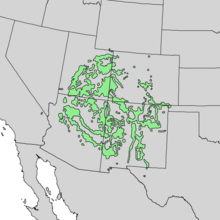Colorado pinyon
| Pinus edulis | |
|---|---|
 |
|
| Colorado pinyons at Bryce Canyon National Park | |
| Scientific classification | |
| Kingdom: | Plantae |
| Division: | Pinophyta |
| Class: | Pinopsida |
| Order: | Pinales |
| Family: | Pinaceae |
| Genus: | Pinus |
| Subgenus: | Strobus |
| Section: | Parrya |
| Subsection: | Cembroides |
| Species: | P. edulis |
| Binomial name | |
|
Pinus edulis Engelm. |
|
 |
|
| Natural range of Pinus edulis | |
Pinus edulis, the Colorado pinyon, two-needle piñon, pinyon pine, or simply piñon, is a pine in the pinyon pine group whose ancestor was a member of the Madro-Tertiary Geoflora (a group of drought resistant trees) and is native to the United States.
The range is in Colorado, southern Wyoming, eastern and central Utah, northern Arizona, New Mexico, and the Guadalupe Mountains in far western Texas. It occurs at moderate altitudes of 1,600–2,400 metres (5,200–7,900 ft), rarely as low as 1,400 m (4,600 ft) and as high as 3,000 m (9,800 ft). It is widespread and often abundant in this region, forming extensive open woodlands, usually mixed with junipers in the pinyon-juniper woodland plant community. The Colorado pinyon (piñon) grows as the dominant species on 4.8 million acres (19,000 km2 or 7,300 sq mi) in Colorado, making up 22% of the state's forests. The Colorado pinyon has cultural meaning to agriculture, as strong piñon wood "plow heads" were used to break soil for crop planting at the state's earliest known agricultural settlements.
There is one known example of a Colorado pinyon growing amongst Engelmann spruce (Picea engelmannii) and limber pine (Pinus flexilis) at nearly 3,170 metres (10,400 ft) on Kendrick Peak in the Kaibab National Forest of northern Arizona.
The piñon pine (Pinus edulis) is a small to medium size tree, reaching 10–20 metres (33–66 ft) tall and with a trunk diameter of up to 80 centimetres (31 in), rarely more. The bark is irregularly furrowed and scaly. The leaves ('needles') are in pairs, moderately stout, 3–5.5 cm (1.2–2.2 in) long, and green, with stomata on both inner and outer surfaces but distinctly more on the inner surface forming a whitish band.
...
Wikipedia

